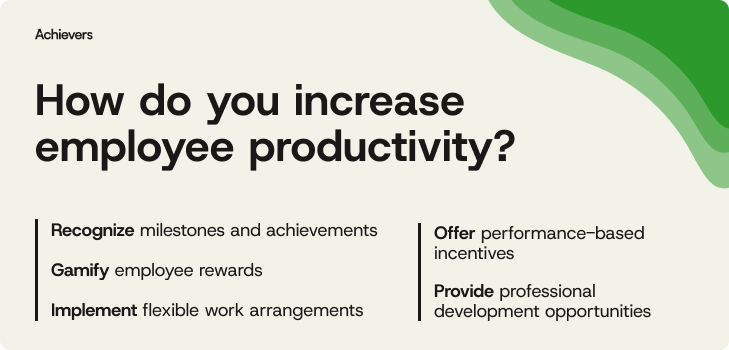Table of contents
Create a culture that means business™
Schedule a demo with an Achievers solution expert today.
Employee productivity isn’t just a number on a report — it’s the pulse of your organization’s health. At its core, productivity shows how well your team turns effort into real, impactful results. When employees are empowered to do their best work, businesses reap the rewards: stronger performance, higher engagement, and growth that sticks.
But let’s be real — boosting productivity isn’t always a walk in the park. Disconnected tools, lack of recognition, low morale, and unclear goals can slowly drain your team’s potential. Fixing these problems isn’t about slapping on quick solutions — it’s about creating strategies that connect, align, and ignite.
In this blog, we’re diving into 10 practical ways to boost employee productivity — from simplifying communication to revamping recognition. Ready to build a workplace where efficiency and engagement thrive together? Let’s see how it works.
Understanding employee productivity
Employee productivity refers to how efficiently employees complete their tasks, typically measured by output relative to input — think quality work done in a reasonable amount of time.
But let’s be clear: productivity isn’t just about churning out tasks. It’s about finding that sweet spot between efficiency and wellness. Overwork leads to burnout, and burnout leads to, well, a lot of coffee breaks. According to Gallup, engaged employees are 17% more productive than their disengaged counterparts.
So, balance is key: drive performance without driving people crazy. A happy team is a productive team — who knew, right?

10 ways to increase employee productivity at work
Increasing employee productivity is a constant goal for any organization, but it’s not just about working harder — it’s about working smarter. By addressing key factors like recognition, clear goals, communication, and work-life balance, companies can create a more efficient, motivated, and engaged workforce.
Here are 10 ways to increase productivity at work while keeping morale high:
1. Foster a culture of recognition and engagement
Recognition is the secret sauce to productivity. Platforms like Achievers celebrate employee wins, big and small, creating a culture of appreciation. When employees feel seen and valued, they perform better. Let’s face it — who doesn’t work harder when someone notices? Recognition = motivation = productivity.
2. Provide clear goals and expectations
Clear goals are your productivity GPS. When employees know exactly what’s expected, they can zoom ahead. SMART goals (Specific, Measurable, Achievable, Relevant, and Time-bound) keep everyone aligned and focused. No one wants to wander aimlessly, so make sure your team has a clear map to follow.
3. Improve communication and collaboration
Communication is like the oil in a productivity engine. Tools like Slack, Teams, or Asana keep things humming smoothly across teams. When employees talk, listen, and share openly, things get done faster and with fewer headaches. Teamwork really does make the dream work — so get chatting.
4. Offer professional development and training
When employees grow, productivity grows. Professional development helps your team level up their skills, turning them into superstars. Leadership programs prepare employees for bigger roles, boosting both confidence and output. A well-trained team is a productive team — so why not invest in their growth?
5. Optimize the workplace environment
A clutter-free desk and a comfy chair can work wonders for productivity. Whether it’s ergonomic furniture or a cozy remote setup, a good environment lets employees focus and thrive. A space that’s designed for success? That’s how you get employees to do their best work.
6. Leverage technology and automation
Tech is your productivity superhero. Tools like Trello and time management apps keep everything organized and on track, while automation handles the boring stuff. AI-driven insights even spot areas for improvement. Let machines do the heavy lifting so your team can focus on what really matters.
7. Encourage work-life balance and well-being
Productive employees aren’t always working — they’re recharging too. Flexible hours, mental health resources, and wellness programs help keep burnout at bay. When employees are healthy and happy, they’re more focused and energized. Work hard, rest harder — it’s all about that balance for long-term productivity.
8. Streamline processes and reduce unnecessary meetings
Let’s be honest — no one loves endless meetings. Streamlining processes and cutting unnecessary meetings means more time for actual work. Focus on the essentials and automate what you can. The less time spent in meetings, the more time employees have to get stuff done — that’s a productivity win.
9. Implement performance tracking and feedback systems
Feedback isn’t just for the end of the year — it’s a productivity booster. Real-time performance tracking lets managers offer guidance and recognition as needed. With the right feedback tools, everything becomes easy and continuous, helping employees improve and stay on track. Regular check-ins keep everyone moving forward.
10. Promote team building and workplace connections
Stronger teams = stronger results. Team-building activities, whether virtual or in-person, help employees bond and collaborate better. A tight-knit team is more productive, and when people enjoy working together, it shows in their output. So, get the team together for some fun, and watch productivity soar.
Key factors that influence employee productivity
Productivity doesn’t happen in a vacuum — it’s shaped by everything from your office culture to your tech stack. Understanding the drivers behind employee performance helps you create an environment where people can thrive (and maybe even enjoy their Mondays). Let’s break down the most important factors — and what happens when they go right… and wrong:
Workplace culture and environment
A good culture brings out the best — while a bad one lights up the exit signs.
- The good: A positive, inclusive culture fuels teamwork and trust. Natural light helps, but psychological safety is what keeps people showing up and pitching in.
- The bad: Toxic cultures kill collaboration and morale. When backstabbing and micromanagement rule, even top talent starts checking LinkedIn.
Employee engagement and motivation
When employees care, they contribute — when they don’t, they coast.
- The good: Recognition, growth, and purpose keep people fired up and focused — even on back-to-back meeting days.
- The bad: Without recognition or meaning, work becomes a soul-crushing grind. Cue disengagement, turnover, and suspiciously long “coffee breaks.”
Access to the right tools and technology
Great tools turn time into output — bad ones turn time into troubleshooting.
- The good: Automation and AI do the heavy lifting, freeing teams to focus on the work that actually matters.
- The bad: Outdated or clunky tools slow everything down. If your software needs a manual and a prayer, it’s time for an upgrade.
Workload management and role clarity
Clear roles and fair loads keep people focused — not frazzled.
- The good: Defined roles and balanced workloads = less chaos and more progress. A little autonomy goes a long way.
- The bad: When everyone’s overwhelmed or unsure of their role, productivity nosedives — right into burnout territory.
Leadership and management style
A great boss lights the way — a bad one blocks it.
- The good: Supportive, communicative leaders build trust, spark ideas, and keep productivity humming.
- The bad: Micromanagers and mixed signals leave teams lost, frustrated, and quietly plotting their escape.
Measuring success: How to track productivity improvements
You can’t improve what you don’t measure — and guessing doesn’t work for productivity. Start with KPIs that align with your goals, like output per employee or project turnaround time. Focus on real performance, not just busy work (spoiler: answering emails fast isn’t always productive).
But numbers alone don’t tell the full story. Employee feedback and engagement surveys give you insights into motivation and support. Achievers helps capture real-time sentiment, so you can track engagement and productivity more accurately.
Take our partner, Sobeys: by integrating recognition and feedback through Achievers, they boosted both engagement and productivity across their 131,000 employees.
The takeaway? Combining KPIs with employee feedback gives you a clear picture of productivity and the tools to improve it.
Driving sustainable productivity: The path forward
Boosting productivity isn’t about squeezing every last drop of energy from your team — it’s about building a workplace where people want to do their best. From fostering a culture of recognition to setting clear goals, streamlining tools, and supporting well-being, the most effective strategies focus on people first, processes second.
If you want long-term results, it’s time to stop relying on coffee and crossed fingers. Invest in the right tools, listen to your employees, and create an environment that helps them thrive. Because when your people are empowered, engaged, and just the right amount of caffeinated — productivity follows.
And the best part? A productive workforce isn’t just good for today’s numbers — it drives retention, innovation, and growth for years to come. Turns out, doing right by your people is also the smartest business strategy out there.



